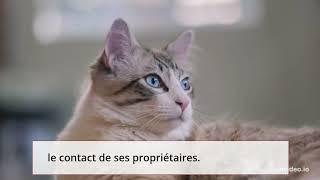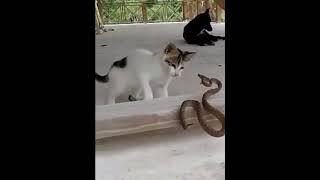Russian Blue, is a cat breed that comes in colors varying from a light shimmering silver to a darker, slate grey. Their short, dense coat, which stands out from the body, has been the hallmark of the Russian breed for more than a century.
the Russian Blue is a naturally occurring breed that may have originated in the port of Arkhangelsk in Russia. They are also sometimes called Archangel Blues. It is believed that sailors took Russian Blues from the Archangel Isles to Great Britain and Northern Europe in the 1860s. The first recorded appearance outside of Russia was in 1875 at The Crystal Palace in England as the Archangel Cat. The Russian Blue competed in a class including all other blue cats until 1912, when it was given its own class. The breed was developed mainly in England and Scandinavia until after World War II.
Right after the war, a lack of numbers of Russian Blues led to cross breeding with the Siamese. Although Russian Blues were in the United States before the war, it was not until the post-war period that American breeders created the modern Russian Blue that is seen in the United States today. American breeders combined the bloodlines of both the Scandinavian and British Russian Blues. The Siamese traits have now largely been bred out. The short hair and slate-gray/blue color is often seen in mixed-breed cats, which can affect breeders and showers due to mislabeling a cat as a Russian Blue.
Russian Blues are plush short-haired, shimmering pale blue-gray cats with emerald green eyes. Guard hairs are distinctly silver-tipped giving the cat a silvery sheen or lustrous appearance. They have been used on a limited basis to create other breeds such as the Havana Brown or alter existing breeds such as the Nebelung. They are being used in Italy as a way to make Oriental Shorthairs healthier and more robust called RUS4OSH in FIFe.
Russian Whites and Russian Blacks were created from crosses with domestic white cats which were allegedly imported from Russia. The first line was developed by Frances McLeod (Arctic) in the United Kingdom during the 1960s and the second line produced by Dick and Mavis Jones (Myemgay) in Australia in the 1970s. By the late 1970s, the Russian White and Russian Black colors were accepted by cat fanciers in Australia as well as in South Africa and now also in the United Kingdom as Russian cats (in different classes). However, the Cat Fanciers' Association and FIFe does not recognize any variation of the Russian Blue.
The Russian Blue has bright green eyes, pinkish lavender or mauve paws, two layers of short thick fur, and a blue-grey-black coat. The color is a bluish-gray that is the dilute expression of the black gene. However, as dilute genes are recessive ("d") and each parent will have a set of two recessive genes ("dd") two non-Color-Point Carrier (non-CPC) Russian Blues will always produce a blue cat. Due to the breeding with Siamese after World War II, there are color-point genes floating around. If two carriers are bred together, then they will produce a litter of mixed colors—solid blue or white with blue-point like a Siamese. People call these CPC cats "color-point", "whites" or "pointed" Russians. In most registries, one cannot register, breed or show a color-point Russian. These color-point (blue-point) cats are called Color-Point-Russian Blue (Blue Point Russian Blue) or more informally as Pika Blu (or pika blue) cats and have the same general characteristics as the Russian Blue cats.
Tail stripes on a Russian Blue
The coat is known as a "double coat", with the undercoat being soft, downy and equal in length to the guard hairs, which are an even blue with silver tips. However, the tail may have a few very dull, almost unnoticeable stripes. The coat is described as thick, plush and soft to the touch. The silver tips give the coat a shimmering appearance. Its eyes are almost always a dark and vivid green. Any white patches of fur or yellow eyes in adulthood are seen as flaws in show cats. Russian Blues should not be confused with British Blues (which are not a distinct breed, but rather a British Shorthair with a blue coat as the British Shorthair breed itself comes in a wide variety of colors and patterns), nor the Chartreux or Korat which are two other naturally occurring breeds of blue cats, although they have similar traits.
00:00 lucky paws
00:06 Russian blue cat
My name is Sedat and I live in Istanbul. Too many homeless cats live in Istanbul. In order to meet the needs of these cats, I opened a youtube channel a long time ago. I feed stray cats , baby kittens , tiny kittens , little kittens , angry cats , angry kittens and cute cats every day. I also do cat neutering , cat spaying , cat rescue and kitten rescue videos. When I see homeless cats and abandoned cats, I build cat houses for them and buy them blankets. I buy tons of cat food and kitten food every month.
#russianbluecat #russiancat #bluecat #russian
the Russian Blue is a naturally occurring breed that may have originated in the port of Arkhangelsk in Russia. They are also sometimes called Archangel Blues. It is believed that sailors took Russian Blues from the Archangel Isles to Great Britain and Northern Europe in the 1860s. The first recorded appearance outside of Russia was in 1875 at The Crystal Palace in England as the Archangel Cat. The Russian Blue competed in a class including all other blue cats until 1912, when it was given its own class. The breed was developed mainly in England and Scandinavia until after World War II.
Right after the war, a lack of numbers of Russian Blues led to cross breeding with the Siamese. Although Russian Blues were in the United States before the war, it was not until the post-war period that American breeders created the modern Russian Blue that is seen in the United States today. American breeders combined the bloodlines of both the Scandinavian and British Russian Blues. The Siamese traits have now largely been bred out. The short hair and slate-gray/blue color is often seen in mixed-breed cats, which can affect breeders and showers due to mislabeling a cat as a Russian Blue.
Russian Blues are plush short-haired, shimmering pale blue-gray cats with emerald green eyes. Guard hairs are distinctly silver-tipped giving the cat a silvery sheen or lustrous appearance. They have been used on a limited basis to create other breeds such as the Havana Brown or alter existing breeds such as the Nebelung. They are being used in Italy as a way to make Oriental Shorthairs healthier and more robust called RUS4OSH in FIFe.
Russian Whites and Russian Blacks were created from crosses with domestic white cats which were allegedly imported from Russia. The first line was developed by Frances McLeod (Arctic) in the United Kingdom during the 1960s and the second line produced by Dick and Mavis Jones (Myemgay) in Australia in the 1970s. By the late 1970s, the Russian White and Russian Black colors were accepted by cat fanciers in Australia as well as in South Africa and now also in the United Kingdom as Russian cats (in different classes). However, the Cat Fanciers' Association and FIFe does not recognize any variation of the Russian Blue.
The Russian Blue has bright green eyes, pinkish lavender or mauve paws, two layers of short thick fur, and a blue-grey-black coat. The color is a bluish-gray that is the dilute expression of the black gene. However, as dilute genes are recessive ("d") and each parent will have a set of two recessive genes ("dd") two non-Color-Point Carrier (non-CPC) Russian Blues will always produce a blue cat. Due to the breeding with Siamese after World War II, there are color-point genes floating around. If two carriers are bred together, then they will produce a litter of mixed colors—solid blue or white with blue-point like a Siamese. People call these CPC cats "color-point", "whites" or "pointed" Russians. In most registries, one cannot register, breed or show a color-point Russian. These color-point (blue-point) cats are called Color-Point-Russian Blue (Blue Point Russian Blue) or more informally as Pika Blu (or pika blue) cats and have the same general characteristics as the Russian Blue cats.
Tail stripes on a Russian Blue
The coat is known as a "double coat", with the undercoat being soft, downy and equal in length to the guard hairs, which are an even blue with silver tips. However, the tail may have a few very dull, almost unnoticeable stripes. The coat is described as thick, plush and soft to the touch. The silver tips give the coat a shimmering appearance. Its eyes are almost always a dark and vivid green. Any white patches of fur or yellow eyes in adulthood are seen as flaws in show cats. Russian Blues should not be confused with British Blues (which are not a distinct breed, but rather a British Shorthair with a blue coat as the British Shorthair breed itself comes in a wide variety of colors and patterns), nor the Chartreux or Korat which are two other naturally occurring breeds of blue cats, although they have similar traits.
00:00 lucky paws
00:06 Russian blue cat
My name is Sedat and I live in Istanbul. Too many homeless cats live in Istanbul. In order to meet the needs of these cats, I opened a youtube channel a long time ago. I feed stray cats , baby kittens , tiny kittens , little kittens , angry cats , angry kittens and cute cats every day. I also do cat neutering , cat spaying , cat rescue and kitten rescue videos. When I see homeless cats and abandoned cats, I build cat houses for them and buy them blankets. I buy tons of cat food and kitten food every month.
#russianbluecat #russiancat #bluecat #russian
- Catégories
- Chats de Race Oriental
- Mots-clés
- rescue cat, cat rescue, rescue kitten















Commentaires